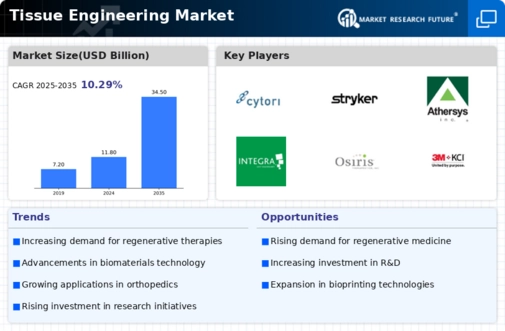The Tissue Engineering Market is characterized by rapid advancements and intense competitive dynamics, driven by the increasing demand for regenerative medicine and innovative therapeutic solutions.
This market comprises a diverse array of players, including biotechnology firms, medical device manufacturers, and research institutions, all striving to develop effective scaffolds, growth factors, and cells necessary for tissue regeneration and repair.
As tissue engineering technologies evolve, competitors are continuously enhancing their product offerings, investing in research and development, and expanding their global reach to capture a larger market share.
Factors such as technological advancements, collaborations, and partnerships are pivotal in shaping the competitive landscape, positioning companies to effectively meet the growing healthcare demands worldwide.
Cytori Therapeutics stands out in the Tissue Engineering Market with a strong focus on regenerative medicine, particularly in the development of therapies aimed at tissue repair and reconstruction. The company's proprietary Cell Therapy technology is a major advantage, granting them a unique position in offering innovative solutions for conditions that require tissue-engineered products.
Cytori Therapeutics has established a solid market presence, supported by a dedicated research pipeline and collaborations with various medical institutions worldwide. The company’s strengths in translating scientific innovation into clinical applications enable it to address unmet medical needs, thereby enhancing its competitive edge in a crowded market.
Moreover, by leveraging their expertise in cellular therapies, the company consistently aims to improve patient outcomes, reflecting its commitment to enhancing the quality of care.
Stryker is a prominent player in the Tissue Engineering Market, known for its comprehensive range of medical devices and implants, particularly within orthopedic and surgical segments. The company offers key products that include tissue scaffolds and regenerative solutions designed to support the healing process.
Stryker's market presence is bolstered by its strong distribution network and significant investments in research and development, making it a leader in innovation within the sector. The company has successfully executed various mergers and acquisitions to expand its portfolio and enhance its capabilities in tissue engineering.
These strategic moves have solidified Stryker's strengths, allowing it to deliver state-of-the-art solutions while capitalizing on emerging market opportunities. Coupled with a commitment to improving patient outcomes, Stryker continues to play a vital role in advancing tissue engineering technologies on a global scale.




















